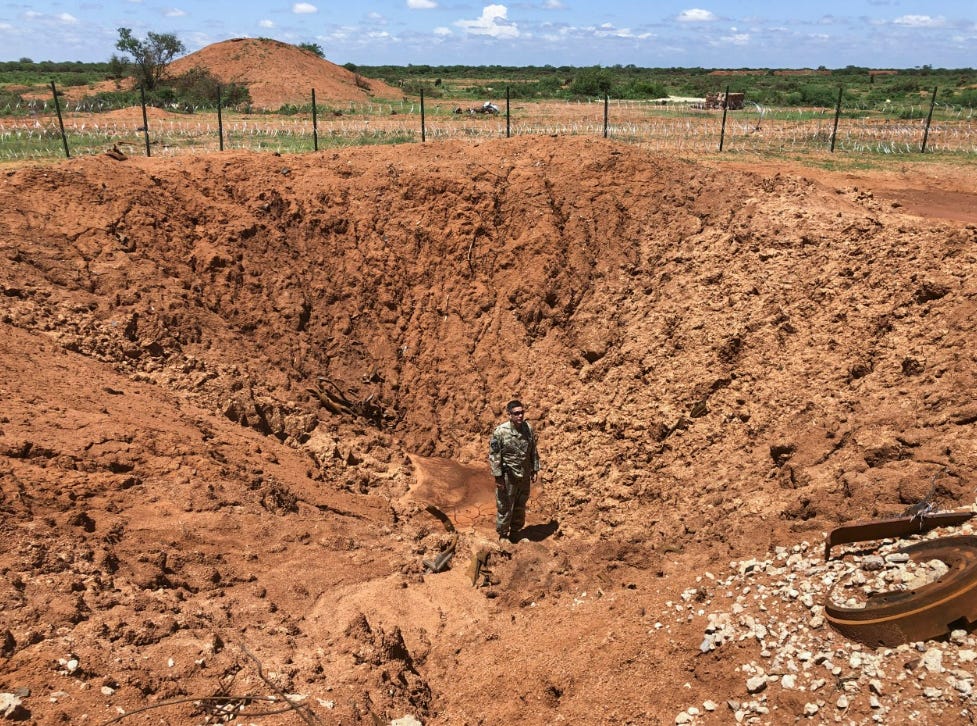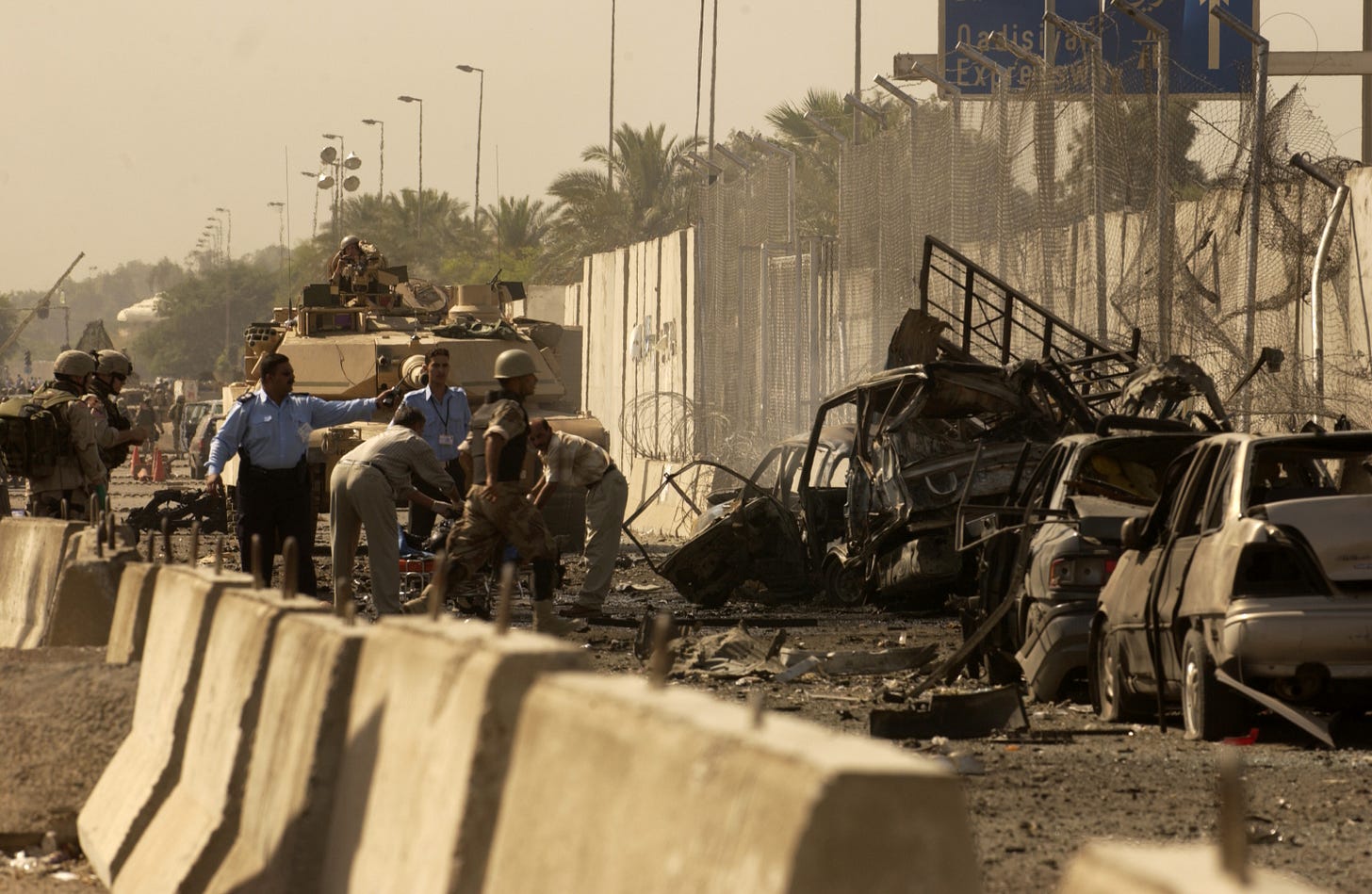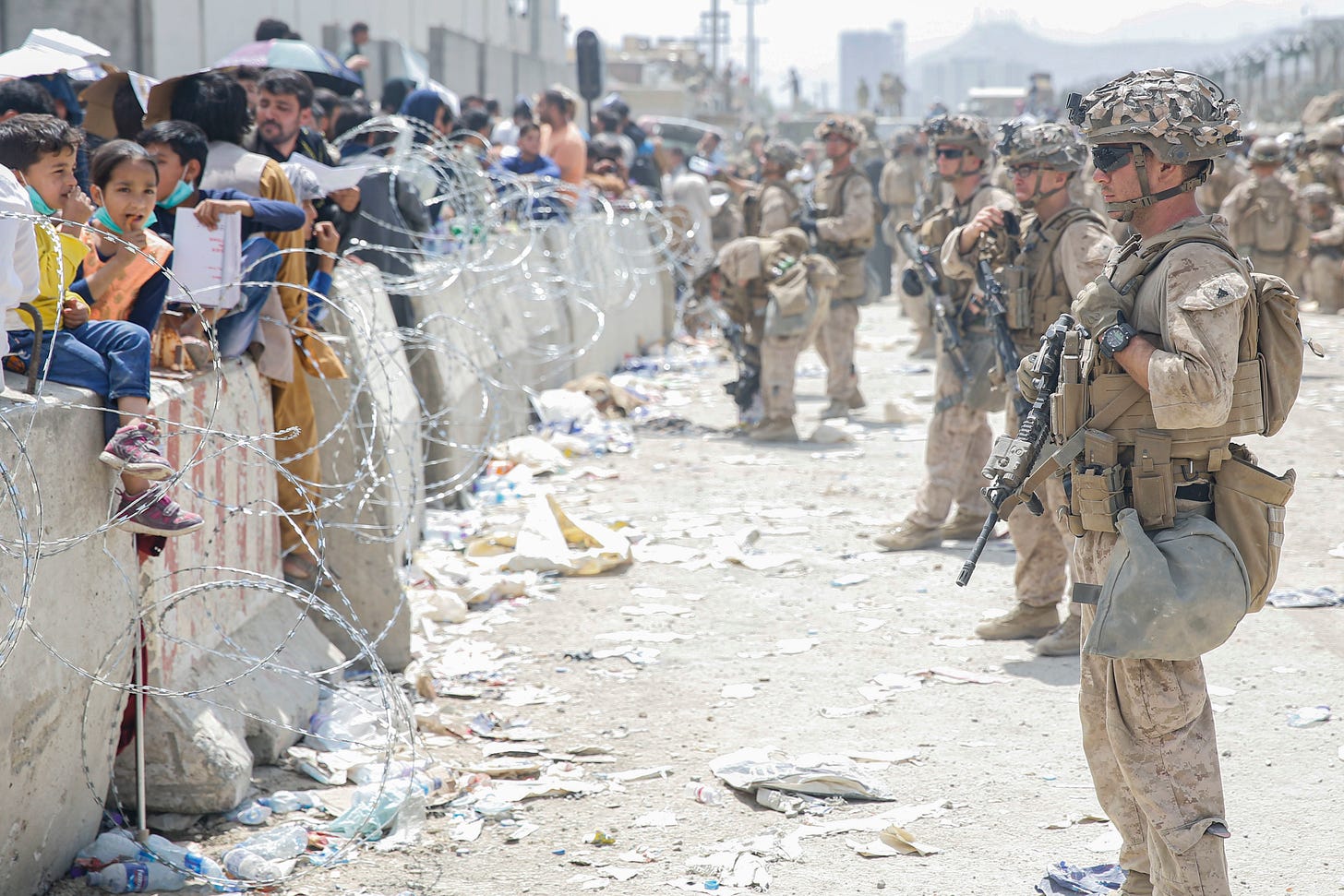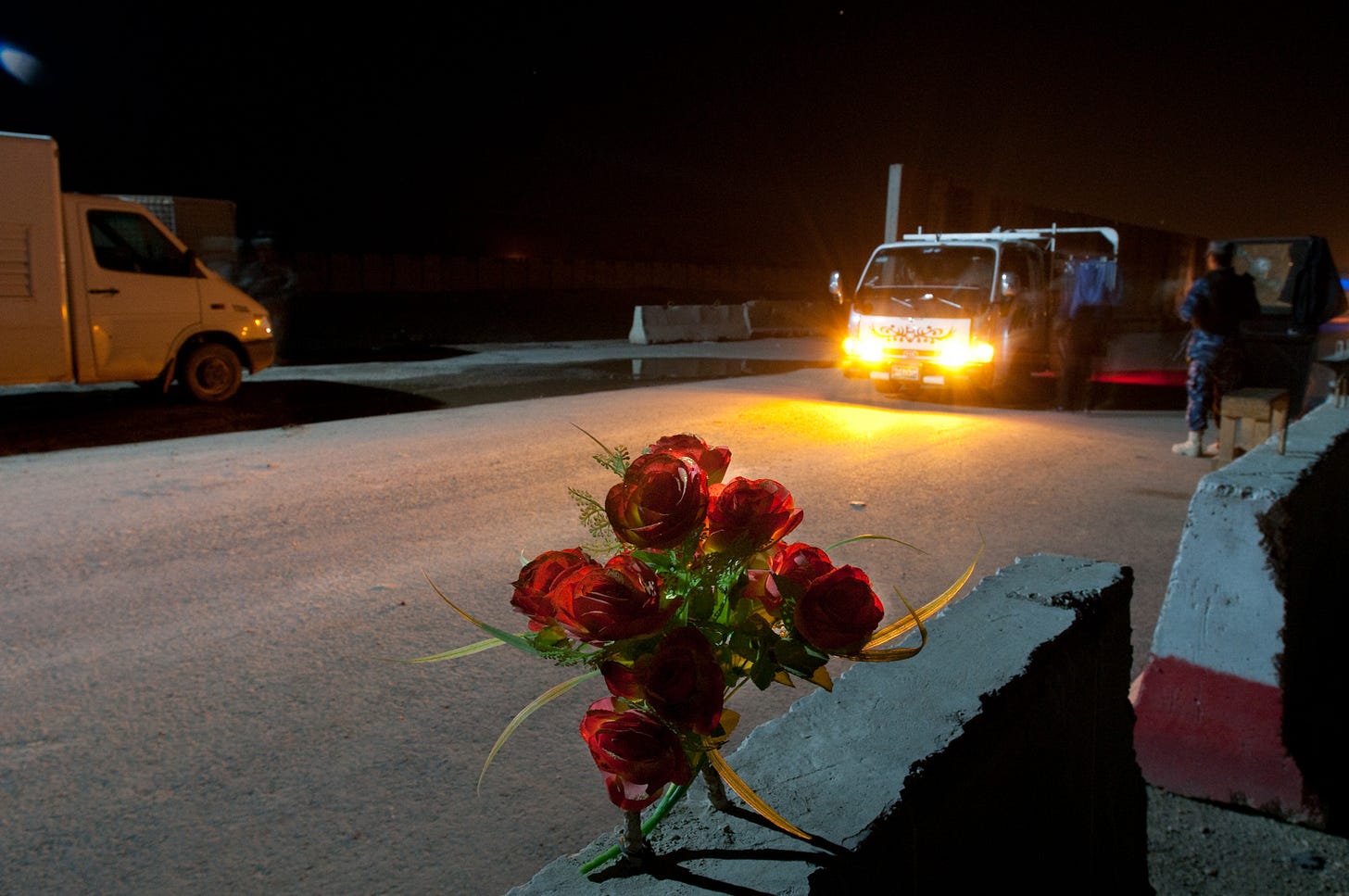The War on Terror and the everyday infrastructure of oblivion
An accidentally timely review of Buda’s Wagon: A Brief History of the Car Bomb
Edited by Althea May Atherton.
A block or so from my house is history’s least-effective roundabout. The traffic circle, put in place at some point in my teen years, is the median point of trying to render a dangerous intersection safe. Before the roundabout, the intersection was already a four-way-stop, with speed bumps added to try and calm traffic in the late 1990s. After the roundabout, cars kept careening into the backyard wall of the house on the south-east corner, eventually leading to cement barriers blocking the road on one side. Cars still crash into the outer wall sometimes, but they do it a lot less frequently as traffic flows, even among drunk drivers speeding home from a tailgate, have rerouted elsewhere.
Cars are a mundane part of life until they suddenly aren’t. The corner where I’d wait for the school bus to middle and high school is on the intersection with the ineffective roundabout, and I wouldn’t think much of the traffic until I’d see the rubbled wall from yet another vehicle that missed the subtle transition from arterial road to a neighborhood street and failed to adjust accordingly. The cement barriers now in place work, mainly by rendering that little stretch of road impassable. The driving that necessitated the barriers is part of what makes Albuquerque the second-deadliest city in the US for pedestrians.
While cars are outright deadly in the routine course of civilian life, the same choices that make car-dependent life possible build the infrastructure cars to be used explicitly as weapons. I knew, intellectually, that cars as weapons had to have a history, but I hadn’t considered the specific, written and published history of car bombs, until I opened the February 5th edition of Ingrid Burrington’s Perfect Sentences newsletter.
In it, I read one of those sentences that wedged in my brain, and transformed how I thought about its subject:
“The next stage in the evolution of the car bomb’s lethality owes something to the Wisconsin Fish and Game Department and the innocent author of Pothole Blasting for Wildlife.” Mike Davis, in Buda’s Wagon: A Brief History of the Car Bomb.
“Lethality” is one of those words that can grate. During the Trump Administration, “Lethality” was the Pentagon’s go-to buzzword, where every new technology pitched and tool sold had to explain how it contributed to the “lethality of the joint force.” The overall effect was that communications software to more easily share powerpoints between bases in Virginia and Afghanistan got spun as a weapon itself, dulling the term’s one clear merit of bringing the violence of war to the foreground.

In Davis’ use, the lethality is literally that, a direct comparison of deaths as attributed to the technique, a topic Buda’s Wagon covers in depth. That an evolutionary leap in car bomb deadliness came from a practical manual from a fish and game department was fascinating.
Within the month, I’d picked up the Buda’s Wagon ebook (the print version appears out of stock) and read it over the course of a couple weeks. Every review emphasizes the book as a slender tome, which is likely as much a commentary on the depth of Davis’ other works as it is about Wagon itself.
What I found most striking about the book as I read it was not its brevity but the timeline. First published in April 2007, the book is suffused with the frantic, world-historical catastrophe of the Bush era. It is a history up to the year 2006, published when the urgency of the bloody Iraq war demanded a perspective steeped in material reality, rather than the pop-phrenology common in the era. The September 11th, 2001 hijacking attacks are covered in the work, though it is Davis’ holistic view that sees planes turned into bombs as not a novel new technique but an adaptation of car bomb strategies, now applied to cars with wings.
“In his 2007 book, Buda’s Wagon: A Brief History of the Car Bomb, published at a time when ideas of ‘Islamic terrorism’ ran rampant, Davis instead chose to place what he called the ‘poor man’s airforce’ in a history that stretched from Italian anarchism to countering Israeli terrorism and post-US-invasion Iraq,” wrote Nihal El Aasar, in an obituary of Davis published at ArtReview. “The car bomb thus becomes a dangerous byproduct of asymmetrical warfare, rather than some wildly irrational strategy.”
If the 2006 use of car bombs in Iraq sparked the urgency of writing Wagon, it’s a deep look at the long history of the tactic that gives the text its name and origin. Mario Buda was an anarchist who in 1920 filled a rented wagon with dynamite and set it off outside Wall Street, in retaliation for the arrest of anarchists Sacco and Vanzetti, and then fled to Italy, never to face official sanction for his act. As Davis notes, there’s an even earlier precedent, including a gunpowder-wagon attempt on the life of Napoleon, but it’s Buda who most clearly sets the scale for modern use of explosive-filled vehicles as weapons. Buda built his weapon out of the tools of the day: commercial explosives, rentable wagons, and a public infrastructure that let a parked cart sit undisturbed until its contents detonated.
“Davis, writing at the height of the war on terror and IED attacks in Iraq, tracks the development and use of car bomb through the 20th century as a technology adapted to the built environment, power distribution, and political logic of the contemporary epoch,” wrote Max Read, in his own accessibly webby obituary for where to start with the writer. “It’s a short, approachable book that’s also a model of how to approach the present through rigorous research into the past.”
By starting from the wagon, Davis built a phenomenology of car bombs so comprehensively that it’s easy to see explosive-filled bicycles, hijacked jetliners, and remotely detonated fertilizer bomb trucks as just variations on the same theme. And while he is focused on describing and understanding the logics of a specific weapon, he never shied from putting it in context with manufactured weapons.

“Like even the “smartest” of aerial bombs, car bombs are inherently indiscriminate: “collateral damage” is virtually inevitable. If the logic of an attack is to slaughter civilians and sow panic in the widest circle, to operate a “strategy of tension” or just demoralize a society, car bombs are ideal. But they are equally effective at destroying the moral credibility of a cause and alienating its mass base of support, as both the IA in Northern Ireland and ETA in Spain have independently discovered,” Davis wrote.
In outlining the evolution of the car bomb as a tool, one with inherent logics and limitations, Davis takes special interest in the kinds of conflicts where these tactics are honed. His section on car bombs in Vietnam starts by looking at a warlord with US sponsorship who pioneered the tactic in-country, before it was perfected by cadres of Viet Cong bombers operating against the government of South Vietnam and hitting at soft targets of the American presence in-country.
Beirut holds a special place in the narrative, as the crucible where so much of car bombing was developed, revised, and perfected, though Davis is clear to outline its earlier middle eastern origins in the far right Stern Gang’s attempt to drive the British Mandate out of Palestine.
This was another sentence Burrington singled out in the newsletter, and one I found myself screenshotting anew as I read the text:
“With so many people trying to kill each other for so many different reasons, Beirut became to the technology of urban violence what a tropical rainforest is to the evolution of plants and insects,” wrote Davis.
It is in a line all that needs to be said, while suggesting infinite details that offer more comprehensive knowledge.
An ecology of weapons and wielders is a compelling way to understand conflict. While not every car bomb needs a car itself, the abundance of cars and car infrastructure leaves security systems with a car-shaped hole, one that can be blasted open with the targeted application of dynamic, plastic explosives, or a fertilizer-fuel mixture.

The universality of cars sets the stage of the universality of car bomb threats. A section on car bombs in Lima, Peru, quotes a 4-year-old who plays “bomba” as a drill, hiding and counting under a table not unlike duck and cover. In some sense, preparation on an individual level for a nuclear blast and a car bomb is largely the same: hope it doesn’t happen, shelter if you have time between the warning and the blast, and hope.
“The car bomb, Davis argues, is a mundane, everyday object which can be transformed into a weapon of enormous potency by relatively “low-tech” means. Their danger is present in their ubiquity (there are cars everywhere) and their low “entrance fee” for weaponization,” writes Alex Wellerstein, in a 2012 piece comparing Buda’s Wagon to Sven Lindqvist’s A History of Bombing.
“For Davis, the car bomb represents the era of the War on Terror, where we are taught to fear the banal, the everyday, the ordinary. “See something, say something,” the subway signs demand of us, and show pictures of otherwise normal looking backpacks and trash heaps — banal objects transformed into deadly threats by their unattendedness and historical context. This “democratization” of war, moving from the provenance of big-technological states (see the aforementioned “war from above”) into the hands of everyday extremists, is the big shift behind the car bomb.”
Throughout the work, Davis references the role of conventional weapons in the conflicts where car bombings happen. In Algeria, violent reactionaries build their bombs with plastic explosives stolen or given from military bases. In Chechnya, an insurgent leader told the press that if he had cruise missiles or intercontinental ballistic missiles, he would use those instead of car bombs and their martyrdom-ready drivers. Everywhere, retaliation to car bombs is played out with distant air strikes.
Insurgent car bombing against the USSR in Afghanistan features prominently, and by the end of Wagon, the chapters are full of the tension between Davis’ desire to get the book into the world, and the knowledge that the escalating use of car bombs in Afghanistan would be a future chapter of the war, and likely the history of the weapon itself. ISIS, the trans-national radically reactionary insurgency and temporary statelet that forms in Iraq and Syria, is not yet on the scene at the time of the writing of Wagon, but the conditions for it are all set, as are the tools by which it will break armies.
“All sides, moreover, now play by Old Testament rules and every laser-guided missile falling on an apartment house in southern Beirut or a mud-walled compound in Kandahar is a future suicide truck bomb headed for the center of Tel Aviv or perhaps downtown Los Angeles,” writes Davis, in the penultimate sentence in the book.
It was fear of car bombs that defined the last month of the United States' war in Afghanistan in August, 2021. The announced and planned withdrawal had proceeded quietly for the first few months of the Biden administration, as observers in the US and Afghanistan maintained some hope that nearly 20 years of state-building had created not just an American auxiliary in-country, but a wholly self-sustained military and state. The rapid advance of the Taliban across the country, despite some fierce resistance in places, led to an evacuation through Kabul, as people fearing retaliation and repression did what they could to get out.

On August 27, Islamic State - Khorasan Province, a sort of ISIS-franchise and Taliban rival in Afghanistan, detonated a bomb vest while in one of the crowded gates to the Hamid Karzai International Airport. Over 170 Afghan civilians died in the blast, alongside 11 US marines, a US soldier, and a corpsman. While this was a bomb vest in a crowd of people, the US feared a second attack might come in the form of a speeding bomb, and two days later, launched a drone strike on a vehicle flagged as suspicious. The information that led to the drone strike proved wrong, and the drone strike killed 10 civilians, including 7 children.
The strike would be as fitting an epilogue to Buda’s Wagon as anything, though of course car bombs and retaliatory strikes hardly stopped in 2021. Once discovered and proven useful, a weapon will persist until successfully neutralized as a threat or consciously abandoned by all participants as a tactic. The materials of car bombs, especially those made from fuel and fertilizer, is as abundant as agriculture, though there have been attempts to design fertilizer in a way that neuters its explosive potential.
Car infrastructure seems similarly insurmountable as a threat vector. Building a world that does not cater to cars can at least keep bombs at some distance, though I expect we’ll see the first electric car turned vehicle-borne improvised explosive device before we see transit infrastructure pitched as a national security alternative to car bombings.
Which means that the likeliest way for car bombings to end is for the groups that would otherwise employ them to abandon the tactic. This is, somewhat, a problem of the inherent ideologies of car bombs.
“The car bomb, when all is said and done, is an inherently fascist weapon guaranteed to leave its perpetrators awash in the blood of innocents,” wrote Davis, a line Burrington emphasized as “[not] pussyfooting around the point!”
While the book is focused on the use and development of the tactic, Davis takes the time to highlight the abandonment of the tactic by the African National Congress, even as it fought against apartheid South Africa.
“The ANC, to be sure, had experimented with car-bombing apartheid in the 1980s, but the tactic divided the movement’s leadership and produced an unprecedented debate about the morality of attacking “soft targets.” Despite tremendous rank-and-file pressure for more aggressive retaliation against white atrocities, Nelson Mandela wrote from his prison cell to criticize guerrilla actions that risked death or injury to innocent civilians,” wrote Davis. “Likewise Oliver Tambo, the exiled ANC president, publicly denounced his own guerillas of Umkhonto we Sizwe for being “inexcusably careless” in a 1984 Durban car-bombing that killed four people.”
In telling the history of a weapon, Davis tells the history of choices made by people embedded in the material infrastructure of the world, and how they chose to adapt those materials to violent ends. As someone whose entire career is spent describing, largely, the tools of violence, it’s another reminder that the infrastructure of daily life dictates the shape of weapons and targets.
I don’t know if I have a book in me, though I’ve long contemplated what, exactly, I might be able to extract from my beat into a full-length story. But should I write one, I’ll look to Buda’s Wagon as the template for how to tell the story of everyday technologies bent to grim ends. The way people farm, travel, and communicate all sets the stage for how people will do violence to one another. What was exceptionally terrifying about 9/11 became mundane during the execution of the War on Terror: people bent on harm to political ends will use the means at hand.
Thank you for reading! I am, as ever, delighted to get to write for you, fleshing out an idea that doesn’t have an easy home elsewhere. I had not intended my reading of Buda’s Wagon to line up so precisely with the 20th anniversary of the launch of the Iraq War, but it is, I think, as good a retrospective as I can offer, outside my Colin Powell obituary or my look at Forever War culture.
I fully intend to have a second newsletter out this month, and schedule-willing two more in April, but for very good reason I cannot promise that. Althea and I are expecting our first child, due mid-April, and when the kid arrives I will take a hard break from work for at least two weeks, including production of this newsletter. (If you’d like to read more about the political coalitions needed to pass paternity leave, I wrote about that in last week’s Critical State).
If you’re new, welcome! If you’re returning, I’ve restarted payments to support my work here. No hard feelings if supporting this letter is no longer in your budget or interests. If you do stick around or haven’t subscribed before and have a few dollars to spare in your budget, know that I and my growing family really appreciate the support I get from readers directly. Thank you, and I look forward to writing for you more in the future.




